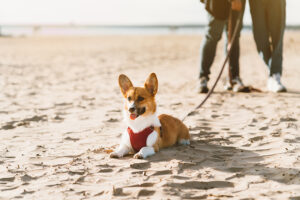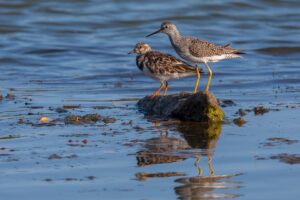To date, little is known about the extent and management of human disturbance to shorebirds in the Caribbean. Thanks to funding from Environment and Climate Change Canada, BirdsCaribbean and Virginia Tech recently partnered to survey Caribbean Waterbird Census (CWC) monitors’ experiences with disturbance at the wetland sites they monitor. CWC monitors first provided feedback via a focus group to share their experiences with disturbance activities and management. This group helped define the definition of human disturbance and applicable disturbance types from a Caribbean perspective:
“Human disturbance to shorebirds is an anthropogenic human activity, or human-induced activity, that directly or indirectly causes an individual or group of shorebirds to alter their normal behavior, leading to an additional energy expenditure by the birds. It disrupts or prevents shorebirds from effectively using important habitats and from conducting the activities of their annual cycle that would occur in the absence of humans. Productivity and survival rates may also be reduced.”
Examples of disturbance activities in the Caribbean include harvesting resources such as salt, dumping of trash, and feral dogs. It was found that among the many pressures faced by shorebirds in the Caribbean, monitors who took part in the survey ranked human disturbance as the greatest threat to shorebirds.
Using the human disturbance definition and the experiences from CWC monitors, the survey was then completed by a wider group who responded with their experiences on the greatest disturbance threats faced in the Caribbean, management strategies to address these challenges, and potential behaviors to promote in an effort to reduce human disturbance through behavior-change campaigns.

Leashing your dog while walking on the beach that allows that activity helps beach birds during migration.
Key findings include:
- Monitors noted that dogs (leashed, unleashed, and feral), dumping (trash, litter, plastic pollution), and wildlife observation (birdwatching, wildlife viewing, research, nature photography) were the most commonly occurring legal and/or illegal potential human disturbances.
- Dogs and dumping also had the lowest levels of public compliance at sites where these activities were restricted.
- One of the most prominent constraints to managing potential human disturbances is that most potential human disturbances are not restricted as they are in other parts of the Flyway, making alternative approaches like education and stewardship and the capacity to do this work essential.
- Monitors described needs for funding to address management gaps, for example, not being able to have education campaigns at an appropriate scale due to the associated cost.
- Due to factors including both occurrence and likely levels of public compliance, focusing on recreational disturbance rose to the top for the most effective focus for behavior-change campaigns through community-based social marketing approach as used elsewhere in the Flyway. Access the CBSM campaign guide.
 Access the report and our findings here!
Access the report and our findings here!
Also, join us for a webinar on March 18, 2024 from 3:00 – 4:15 EST to learn more about human disturbance in the Caribbean and how community-based social marketing can be an effective tool to address the challenge of human disturbance. Register through this link!
The findings of this work will pave the way for future community-based social marketing campaigns tailored to the unique challenges of the Caribbean.


